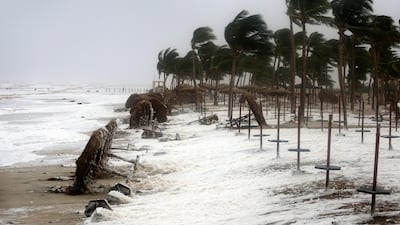It has been less than six months since the great washout of 2017, when heavy rains flooded the UAE's roads and emergency services were inundated with more than 12,000 calls. As Cyclone Mekunu wreaked havoc and fatalities across the region – killing a 12-year-old girl in Oman – it was a stark warning of the dire need for disaster planning. Thankfully, while the UAE seems to have escaped the worst of the storms – although rain and sandstorms could still affect the country – it has a well-orchestrated mechanism in place to cope in the face of natural or man-made disasters, thanks to its national emergency, crisis and disaster management authority. Last year the authority said it was developing advanced smartphone warning systems for use in emergencies. Among its pre-emptive measures to protect against a possible future crisis, the country has already implemented various strategies such as underground desert reservoirs to ensure the country does not run out of water. Moreover, the UAE's health care infrastructure is geared to respond quickly if needed. But natural disasters are by their very nature unpredictable and more can always be done to limit their impact when they strike. Education and damage limitation measures are the best places to start.
The nation has not been the locus for a cataclysmic natural disaster in living memory but that has not stopped it from developing its disaster response capacity and deploying it abroad to help those hit by crises. Sizeable donations have gone to the Rohingya Muslims trapped in Bangladeshi refugee camps while the UAE will fund the reconstruction of the Great Mosque of Al Nuri in Mosul, as The National reported last month. When disaster strikes in the Middle East, the UAE's Arabic-speaking aid workers bring cultural understanding to their communication with victims. In 2015 alone, the country's government agencies and NGOs contributed Dh32.34 billion in aid to 155 countries, from Somalia to Thailand to Yemen.
While aggressive weather patterns are rare in this region, no country is safe from freak weather and the looming threat of natural disasters. Less than 48 hours after Cyclone Mekunu struck the Yemeni island of Socotra – cutting electricity lines, filling the streets with water and leaving two dead and dozens missing – a UAE plane carrying 40 tonnes of relief supplies from the Khalifa bin Zayed Al Nahyan Foundation (KF) was in flight. By the time the plane landed on the small island on Saturday, the Emirates Red Crescent had already reopened the main road connecting the airport and the main city of Hadibou. It encapsulated the speed and generosity that has made the UAE a leading provider of aid and crisis assistance and a hub for relief agencies.

